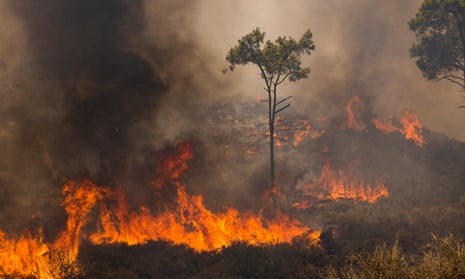The return of El Niño against the backdrop of the climate crisis will hurt people’s health in many parts of the world, scientists have warned.
The hot natural weather pattern is back after three years of its cooler sister, La Niña, the World Meteorological Organization (WMO) confirmed last month. As it grows stronger, scientists fear it will raise the risk in some countries of hunger, drought and malaria.
Coupled with hotter global temperatures from burned fossil fuels, the shift could make a host of heat-related dangers worse, from heart disease to suicide.
“Heat is unambiguously dangerous,” said Gregory Wellenius, head of the centre for climate and health at Boston university’s school of public health. “Sometimes it leads to hospitalisation, other times it leads to death. Then there’s indirect impacts that follow up on that.”
El Niño is the result of natural shifts in winds and ocean temperatures. It brings heavier floods to some parts of the planet while drying others out. The last major El Niño was in 2016, which was the hottest year on record.
Because scientists know that weather patterns have changed this year, people and governments can better prepare in the regions affected.
“El Niño does not mean more disasters globally than in any other years,” said Walter Baethgen, a scientist at Columbia university’s international research institute for climate and society. “What it does change is our ability to predict what the climate will be in some parts of the world. That’s going to help us take anticipatory actions.”
A particular worry is the effect on food security. Shocks to weather patterns could be fatal for farmers in countries already reeling from the Covid-19 pandemic, Russia’s invasion of Ukraine and extreme weather events made worse by the climate crisis.
“To be realistic, many countries do not have many degrees of freedom,” said Baethgen, referring to their ability to stave off hunger they know is coming. But other actors such as the UN and the World Food Programme can use the information to prepare, he added. “They know in El Niño years some areas will have an increased threat of food insecurity.”
In Ethiopia, for instance, El Niño typically spells drought in the north of the country, said Madeleine Thomson, head of climate impacts and adaptation at the charity Wellcome. On top of that, there may be a greater risk of infectious diseases. “People who live at high altitude are not normally exposed to malaria because it’s basically too cool for transmission.
“We’ve seen from historical data that when you have an El Niño, you tend to get an increase in transmission in areas in the highlands where the populations are not immune, so they’re at risk.”
The combination of global heating and El Niño has led to a flurry of temperature records being broken in recent weeks. Before the month was up, the WMO declared July 2023 the hottest month on record.
Greenhouse gases, which have clogged up the atmosphere and heated the planet 1.2C since the Industrial Revolution, drove up the temperatures of deadly heatwaves in July in North America, southern Europe andeast Asia, according to the World Weather Attribution network.
“We’re venturing into uncharted territory,” said Chris Hewitt, head of climate services at the WMO. “As it gets warmer and warmer, the impacts are likely to get worse.”
For that reason, he added, it was important to stop the planet heating and keep temperature rise “as low as possible”. “Every increment increases the risk,” he said.
